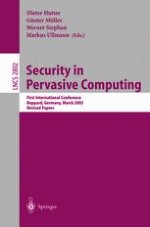2004 | OriginalPaper | Chapter
Enlisting Hardware Architecture to Thwart Malicious Code Injection
Authors : Ruby B. Lee, David K. Karig, John P. McGregor, Zhijie Shi
Published in: Security in Pervasive Computing
Publisher: Springer Berlin Heidelberg
Included in: Professional Book Archive
Activate our intelligent search to find suitable subject content or patents.
Select sections of text to find matching patents with Artificial Intelligence. powered by
Select sections of text to find additional relevant content using AI-assisted search. powered by
Software vulnerabilities that enable the injection and execution of malicious code in pervasive Internet-connected computing devices pose serious threats to cyber security. In a common type of attack, a hostile party induces a software buffer overflow in a susceptible computing device in order to corrupt a procedure return address and transfer control to malicious code. These buffer overflow attacks are often employed to recruit oblivious hosts into distributed denial of service (DDoS) attack networks, which ultimately launch devastating DDoS attacks against victim networks or machines. In spite of existing software countermeasures that seek to prevent buffer overflow exploits, many systems remain vulnerable.
